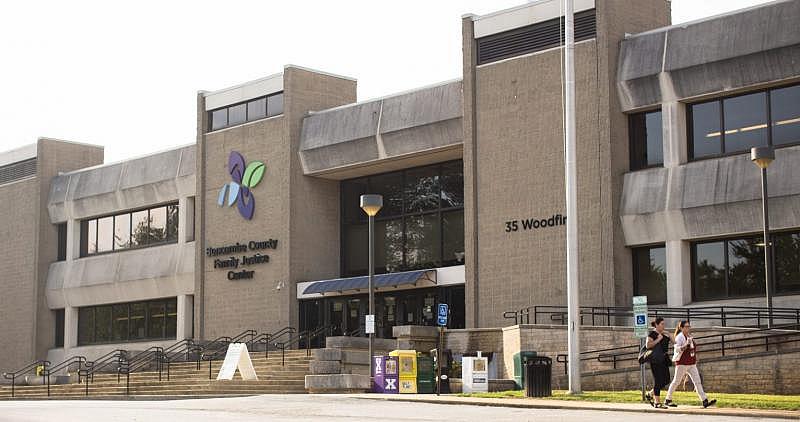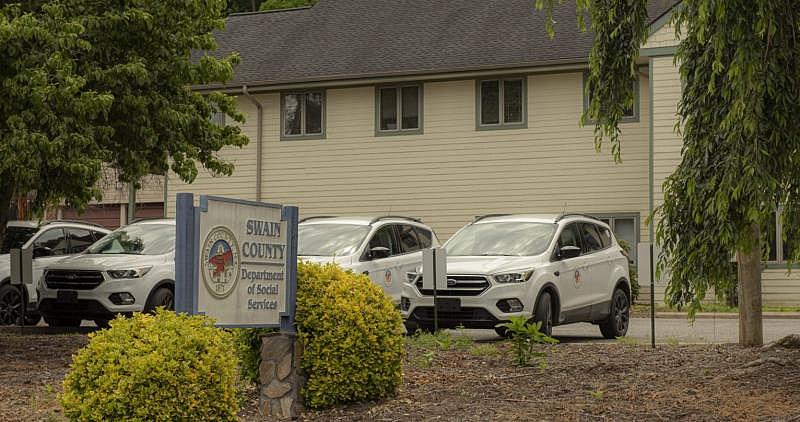Part 2: Stories recount concerns with DSS agencies across North Carolina
This is part 2 of the four-part investigative series “Patchwork Protection” produced by Kate Martin for the USC Annenberg Center for Health Journalism’s 2020 Data Fellowship.
Her other stories include:
Part 1: Protection of NC children, families depends on the county
Part 3: Structure of NC child protective services leads to inequity
Part 4: NC could look to other states for potential child welfare reforms
Indicted former director resigns from DSS position, can’t work for county again

Buncombe County Health and Human Services Director Stoney Blevins sits at his desk in Asheville. Blevins was asked to testify before the General Assembly last year about how social workers handled a case, but his hands were tied by confidentiality rules.
Colby Rabon / Carolina Public Press
By Kate Martin, Frank Taylor and Imari Scarbrough
Their stories were often shocking and always emotional.
Angry and desperate parents, grandparents, aunts and uncles have contacted Carolina Public Press for years hoping to share their stories and possibly get help in investigating what went wrong with their families’ experiences with child protective services in North Carolina counties.
Henderson County resident Felicia Reeves disappeared in August 2015. A week later, the mother of two was found dead in a New Jersey motel room. New Jersey officials ruled the case a suicide, but a Carolina Public Press investigation identified problems with this explanation that have never been resolved.
But Reeves’ death was only part of the case. When Reeves’ sister, Suzan Bayorgeon, contacted CPP in late 2015, her family was distraught not only over Reeves’ death but also because they did not know the whereabouts of her youngest son, Addison.
Reeves’ family said she had lived in fear for her life because of attacks from her ex-husband Titus Boley, who had served a prison sentence for assaulting her. She was concerned the children could be injured if he attacked her. Years before she died, she worked with departments of social services in multiple counties to arrange for Reeves’ mother to care for the older son. But the grandmother said she could not care for Addison, Reeves’ younger child, at that time. Addison was placed in foster care in Transylvania County.
During visitation with the family in 2014, they noticed marks on him, which led to a Department of Social Services investigation. Social workers removed him from the foster care setting, but the family remained unclear about what happened to him next, they told CPP.
In a case of suspected abuse in a foster care setting, DSS is obligated to notify law enforcement. A CPP investigation nearly two years later found that the family had notified the Brevard Police Department. But the foster care residence was in unincorporated Transylvania County, not the city of Brevard.
Police later claimed that they emailed information about the case to the Transylvania County Sheriff’s Office. But the Sheriff’s Office had no record of it. There appeared to be no attempt by the police or DSS to follow up with the Sheriff’s Office.
When CPP brought the case to the attention of deputies in 2016, they conducted an investigation. The DSS agent who had documented the abuse in foster care no longer worked there by this time. It was unclear whether photos documenting bruises were taken immediately or later, but they showed far less bruising than the family remembered seeing.
The district attorney’s office decided that the evidence justified charges of misdemeanor child abuse, but not a felony. As a result, the family said, the statute of limitations had expired, and no one could be charged two years later. A spokesperson for the N.C. Department of Health and Human Services told CPP at the time that the foster mother would no longer be able to foster children in North Carolina. Addison Boley at 2 weeks old. Photo courtesy of Suzan Bayorgeon.
Meanwhile, Addison’s birth family had no idea what had happened to him after removal from foster care.
Records from Reeves’ communications during the final weeks of her life show that she was repeatedly at odds with DSS agents over her son, though what she knew about his location was not clear.
Court records from the case show that the judge recognized the ultimate goal of reuniting the boy with his family when possible, and while the father’s rights had been terminated, Reeves’ rights were intact.
In September 2016, a CPP investigation learned that the boy had been adopted within weeks of his mother’s death. His grandmother and aunt told CPP that they would have taken him so that he could grow up alongside his brother, but no one from DSS contacted them.
Tracy Jones, who was DSS director in Transylvania County in 2016 but not during the time of the foster care abuse allegation, told CPP that the agency’s procedure during an adoption is always to notify the next of kin first. She wasn’t sure why that didn’t happen in Addison’s case, and privacy laws prevented her from discussing the details.
Adoptions in North Carolina cannot be reversed.
Families’ stories
Over time, many families have contacted Carolina Public Press about child protective services concerns.
The allegations parents brought to CPP ranged widely: Social workers refused to screen in a case of extreme negligence involving meth-addicted parents despite repeated urging from a grandmother. Social workers removed children seized over a mark from a supposed beating, even though there was no evidence of the mark. A social worker ordered a family to banish the family dog, who had bitten no one. DSS seized children during a drug raid that found no evidence and was conducted at the wrong house on warrants intended for a search elsewhere.
Families from many parts of North Carolina who contacted CPP made repeated claims of social workers and social services lawyers insulting families for being poor, uneducated, Black, Cherokee, Lumbee, from out of state, the wrong religion or simply for not being knowledgeable about the policies of that jurisdiction. Some families accused DSS staff of generally playing God with people’s lives and acting in a conspiratorial manner.
They described social workers ignoring judges’ instructions on keeping families together, social workers who acted on personal dislike of their families and irreversible adoptions that did not follow policy or the law and inappropriately kept family members in the dark about what was happening.
People who lose their children or are unsuccessful in having children removed from the home of a troubled family member are not happy about these outcomes. The experience is typically traumatic and humiliating. They may think the system has wronged their families.
The legal and bureaucratic system surrounding child removals can be difficult to navigate, so that even social workers from one county may find aspects of how things are done in another county quite alien, and the average person is unable to make sense of what’s happening.
Challenges of confidentiality
Most of the allegations CPP has received from families are nearly impossible to substantiate. Some of them are likely true. A good many are probably false or contain half-truths. It’s often impossible to know because the evidence surrounding child protective services is not available to the public.
In some cases, people may have kept enough records and can present a credible account shored up by documentation. But even in some of these cases, legal counsel may ultimately advise them not to discuss the situation further. Or a family who had contacted CPP initially might not be able to talk now because of a settlement that included a nondisclosure agreement. The Family Justice Center in Asheville houses the Buncombe County Department of Health and Human Services, including its child protective services division. The building also houses nonprofit organizations that work with sexual assault and domestic violence victims. Colby Rabon / Carolina Public Press
Strong confidentiality rules surround child protective services cases under both state and federal law, for the purpose of protecting the identity of the children. When news organizations contact local departments of social services offices with questions about a specific case, the agencies are typically unable to discuss them.
At other times, however, DSS agencies have cited confidentiality rules as reasons for not responding to questions about their general procedures and policies that require no identifying information about individual children and families.
This interpretation of the rules can make it difficult for other branches of state government to hold DSS agencies accountable for possible mistakes, much less the news media, which has no access to subpoena powers.
Even without names or narratives, the overall data from the last decade points to locations in the state where removals of children have occurred far above or far below the statewide average.
Responding to officers in Buncombe
In 2020, police in Black Mountain pulled over a swerving car and arrested all three adults. But what to do with the 9-year-old girl? By the officers’ account, the father told them to take her to a needle-infested hotel room and leave her with a man she did not know. She told the police she wanted to go home.
The police reported that an officer called Buncombe County DSS but then hung up on the social worker. The DSS worker called back and asked him to help complete the intake report. The officer wrote in his report, “I told her I did not have time to do that, I had to find a safe place for the child. I ended the phone call.”
The General Assembly called Buncombe County Health and Human Services Director Stoney Blevins to testify about the incident. Some lawmakers were incensed. Why didn’t DSS show up on the scene? Didn’t they care this girl was going to be left with someone she did not know?
Much to lawmakers’ chagrin, Blevins could not confirm or deny anything in the police report due to strict laws protecting the privacy of the girl and her family.
“We would never support leaving a child in a hotel room with a stranger and 300 used needles, as a blanket statement,” Blevins said last year.
A year ago, Buncombe County updated its policy, and social workers now respond to any law enforcement officer’s request for a social worker on the scene.
Navigating a confounding system
Catherine Noyes is a grandmother who expresses frustration over the Cabarrus County Department of Social Services’ and courts’ handling of her family’s case.
Although Noyes had previously assisted in caring for her daughter’s children and remained willing to do so, DSS ultimately removed them instead and persuaded the court to place the children with their father. Not long afterward, he died of an overdose.
Noyes questions, among other things, why the children were placed with him rather than her and why his substance abuse issues were not adequately investigated by DSS.
Noyes said she continues to work with her daughter to regain custody of the children but has become disappointed by the process.
“They’ve ripped (the grandchildren’s) family apart,” Noyes said. “I mean you can’t get back the last couple years of these little children, you know.”
At one point, Noyes believed that an employee of DSS had an inappropriate previous professional relationship with a judge who handled the case. Although she filed a complaint, she said it was not taken seriously.
The Cherokee County Department of Social Services building in Murphy. Frank Taylor / Carolina Public Press
Noyes said at first she thought that if you worked through the system and presented your case honestly, the situation would work out, but she now has no confidence in DSS and the family courts, a view she said is shared by members of other families whom she’s talked with during court appearances.
“I can understand why a lot of people give up and stop fighting because, one, you’re fighting a hard system, and two, you can’t afford it,” she said.
“It’s just disturbing. I’m so disgusted with the system. I thought I had faith in it, but I don’t anymore.”
Falsifying records, not monitoring safety
Once social workers take in a child, every interaction is supposed to be closely monitored. They visit the parents, then write down what they say. After children return to the home, social workers stay in touch to make sure they are safe.
Social workers are supposed to try to make these contacts regularly. But sometimes social workers fudge. Shortly before DHHS discovered Cherokee County was using unlawful agreements to separate families, a report about a three-day visit to the department included dire concerns.
DHHS Children’s Program representative Brian Vogl “stated concerns for falsifying the foster care monthly contact records — these are identical, and they are falsifying these records,” the memo stated.
“These records are tied into funding. A parent’s attorney could get a hold of these records and make an argument to have the kids returned home.”
Forging contact records is not trivial. A decade ago in Swain County, 15-month-old Aubrey Kina-Marie Littlejohn died while under supervision by county DSS.
The Swain County Department of Social Services office in Bryson City. Jacob Biba / Carolina Public Press
Family members had warned social workers multiple times she was in danger and had received no response from DSS, according to the Smoky Mountain News. She died during the winter, wearing only a T-shirt and her diaper. Her trailer had no heat, according to statements to law enforcement.
An Associated Press investigation into Littlejohn’s death found social workers forged documents to cover their tracks after the girl died to show the visits had occurred when they in fact had not.
Ideally, when social workers conduct their monthly home visits, they look for changes in the home. Are new people living there? Does the child feel safe? Is everyone healthy and is there enough food?
Zahra Baker was a native of Australia who lived in Catawba County with her father and stepmother. Her school reported abuse, and multiple social workers visited the family.
Baker’s stepmother was already the subject of previous abuse findings. But Zahra was never removed from the family.
She died in 2010, and her stepmother was eventually charged in her murder. The case made international headlines over the following months, focusing a world spotlight on the total failure of the child protection system in her case.
In 2016, Rylan Ott, nearly 2 years old, wandered from his Carthage home and drowned in a pond.
A later independent investigation into Moore County’s Department of Social Services revealed that overworked caseworkers did not visit the mother as they were supposed to, and the department did not properly supervise its caseworkers to ensure they followed state law and policy, according to the Fayetteville Observer.
The boy’s death spurred lawmakers to action, and the General Assembly approved a package of major reforms with strong bipartisan support.
The law gave DHHS authority to enforce performance standards at each county, and for DHHS to take over DSS offices that chronically underperform — an authority DHHS used a few months later when it took over Cherokee County’s child welfare division.
Records delays frustrate prosecutions
A horrific child sex abuse case in Cherokee County two years ago included a puzzling delay by DSS officials in cooperating with prosecutors.
For several months DSS did not produce confidential child welfare records for a criminal case after the DA’s office sought them. Such records are typically open to prosecutors, according to Peg Dorer, with the N.C. Conference of District Attorneys.
State law also allows DSS offices to disclose records to prosecutors without court orders, said Sara DePasquale, an associate professor specializing in child welfare law at the UNC School of Government, two years ago.
“If the purpose of the record request is to protect a juvenile, then no court order would be needed,” DePasquale told CPP.
The elected district attorney, Ashley Welch, told CPP then that she took an unusual step of filing a motion to compel DSS to provide documents after her office was repeatedly denied an opportunity to view the records. A judge granted the request.
A grand jury first indicted the mother for neglect in 2015. But it took years for one young child to disclose what happened to her in the home.
The parents used intravenous drugs in the presence of their children and failed to provide adequate nutrition and hygiene, the indictments said. Prosecutors filed additional charges, including incest, aiding and abetting incest, child prostitution and other felony sex offenses involving multiple close relatives.
Cherokee County DSS never responded to CPP’s questions about the records fracas but provided the records to the DA’s office after CPP published a story about the issue.
One relative was convicted last year and is serving a 12-year prison sentence, another is serving a suspended sentence of five years, and a third is serving a two-year prison sentence. CPP is not naming the adults because naming them could identify the young children.
“It’s regretful there were some communications mishaps,” said Cherokee County DSS Director Amanda McGee in a later interview on WKRK, a radio station in Murphy.
“I didn’t realize there was a significant problem. I thought we were waiting for them to copy the records.”
// 800 ) { vizElement.style.width='870px';vizElement.style.height='727px';} else if ( divElement.offsetWidth > 500 ) { vizElement.style.width='870px';vizElement.style.height='727px';} else { vizElement.style.width='100%';vizElement.style.height='1027px';} var scriptElement = document.createElement('script'); scriptElement.src = 'https://public.tableau.com/javascripts/api/viz_v1.js'; vizElement.parentNode.insertBefore(scriptElement, vizElement); // ]]>
What the map says
CPP’s news team analyzed data on child removals across North Carolina during the decade from 2010-19. Then, using the child population of each county during the year in question, reporters calculated the percentage of children removed in a given year.
From these annual rates in each county and the state as a whole, CPP calculated an average yearly rate over the 10-year period, then compared each county to the state.
Each county’s average annual removal rate, compared with the state’s annual removal rate, was calculated as a percentage of the state’s rate. A county with an annual removal rate exactly the same as the statewide rate would have a 100% comparison rating, a county that removed children on average at twice the statewide rate would have a 200% comparison rating, and a county that removed children on average at half the statewide rate would have a 50% comparison rating.
CPP then mapped these comparison percentages, marking distinctly those at the extremes. Counties removing children at more than 150% of the state average rate were marked high, while those removing children at 200% or more are marked very high. Those removing children at two-thirds the state rate are considered low, and those removing at less than half the state rate are considered very low.
A simple takeaway from the map is that the state has many counties at either end of the spectrum, far removed from the statewide average.
But the map also shows that the high and very high counties mostly cluster geographically, as do the low and very low counties.
The largest concentration of counties that are removing children at high or very high rates are in the western mountain counties, though a smaller cluster also exists in the southeastern counties, and a few other exceptions are scattered across the map.
Low counties are clustered in the rural northeastern counties, which typically have very low populations. But others include the major Piedmont metro areas, which have some of the highest populations.
Many of the counties with very high removal rates have elevated poverty rates, but no direct correlation exists between poverty levels and child removal rates. Many of the counties with very low rates or rates in the middle also experience poverty. And some economically advantaged counties may also cluster with high or low removal rates.
Policy choices are made by individuals, though geographical isolation and limited resources may promote decisions in some areas of the state more than others.
If county officials decide to go beyond the scope of state guidelines, or in some cases beyond what state and federal laws allow, those choices are being made by individuals, some of whom already face criminal prosecution.
Editor’s note: This is part 2 of the four-part investigative series “Patchwork Protection.” Part 1 appeared June 7. Upcoming articles in this series will examine the systemic problems that create challenges for child protective services in North Carolina and potential solutions. This project was produced for the USC Annenberg Center for Health Journalism’s 2020 Data Fellowship. Carolina Public Press contributing reporter Christian Green also assisted with interviews for this article.
[This story was originally published by Carolina Public Press.]
Did you like this story? Your support means a lot! Your tax-deductible donation will advance our mission of supporting journalism as a catalyst for change.

